Unit 11 How was your school trip?一般过去式语法讲解课件(共24张PPT)
文档属性
| 名称 | Unit 11 How was your school trip?一般过去式语法讲解课件(共24张PPT) |  | |
| 格式 | pptx | ||
| 文件大小 | 932.2KB | ||
| 资源类型 | 教案 | ||
| 版本资源 | 人教新目标(Go for it)版 | ||
| 科目 | 英语 | ||
| 更新时间 | 2023-05-20 08:17:40 | ||
图片预览

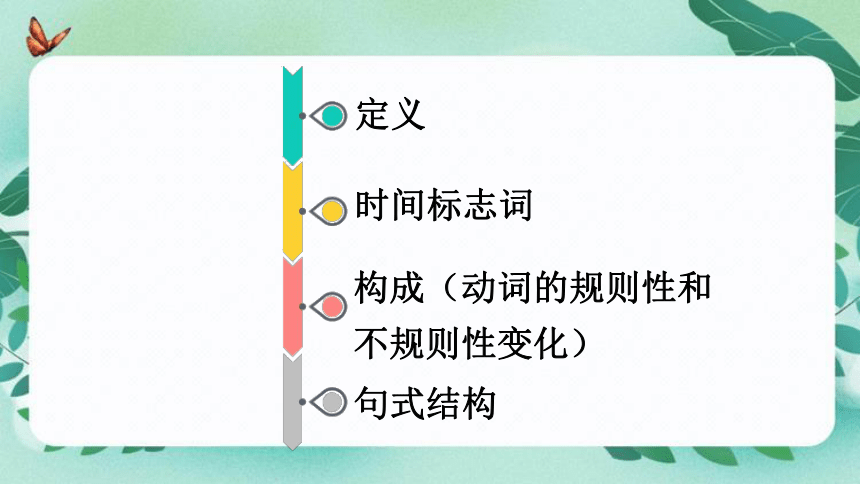
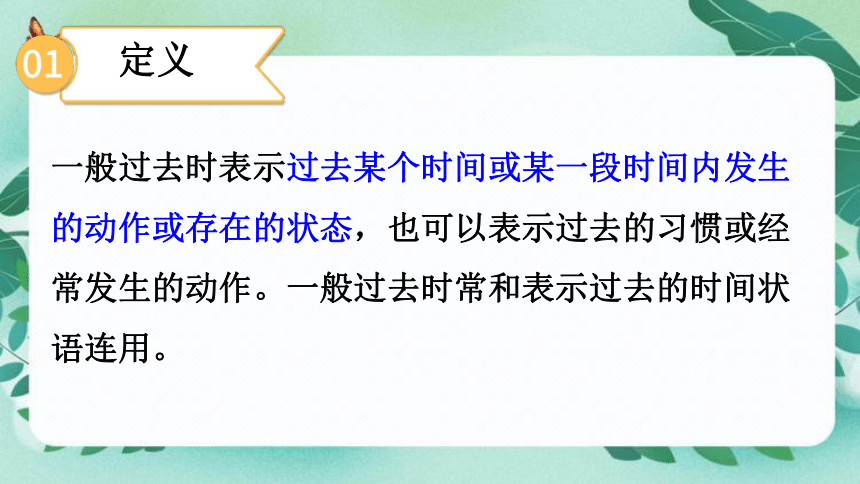
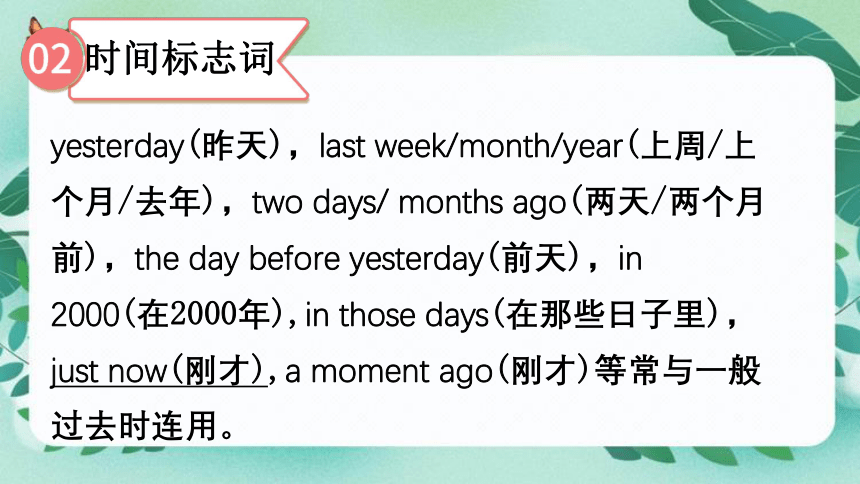

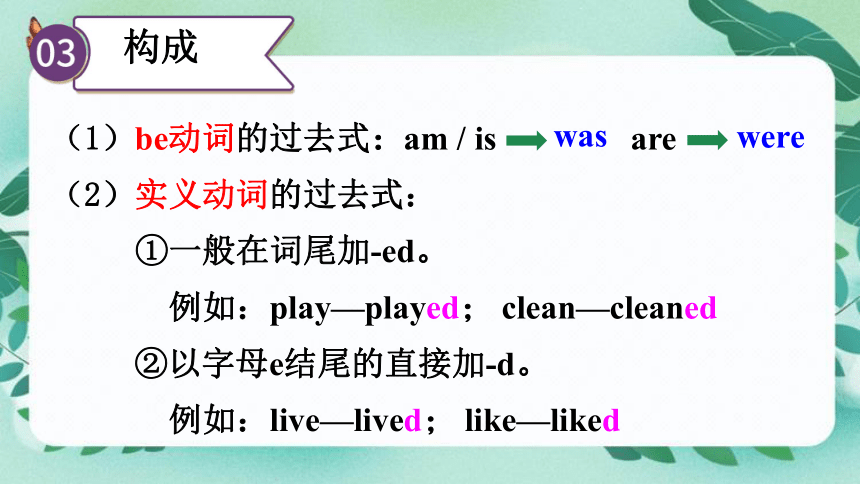

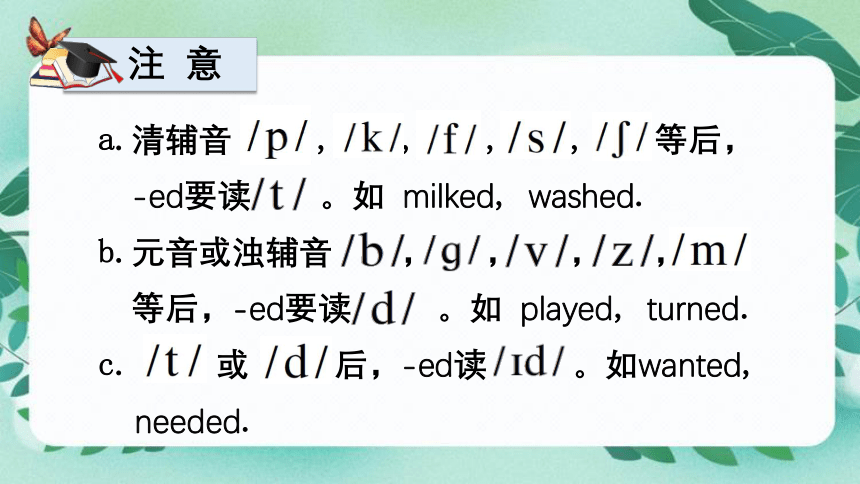
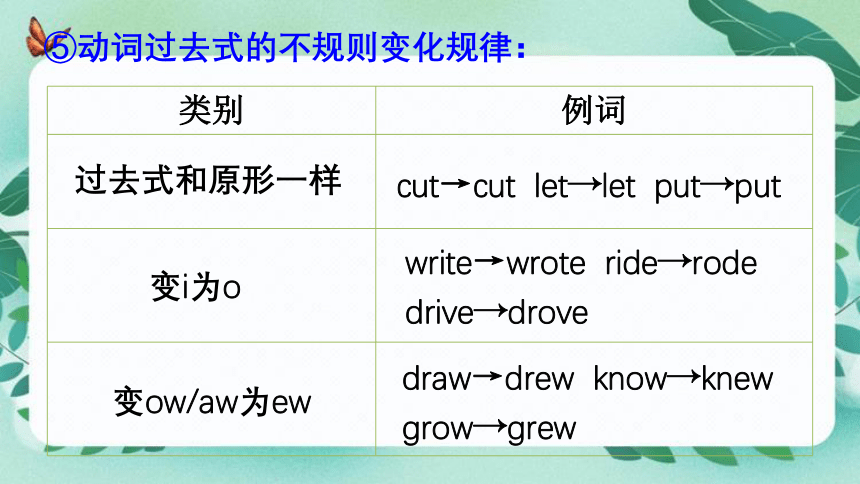
文档简介
(共24张PPT)
一般过去时
定义
构成(动词的规则性和不规则性变化)
句式结构
时间标志词
一般过去时表示过去某个时间或某一段时间内发生的动作或存在的状态,也可以表示过去的习惯或经常发生的动作。一般过去时常和表示过去的时间状语连用。
定义
yesterday(昨天),last week/month/year(上周/上个月/去年),two days/ months ago(两天/两个月前),the day before yesterday(前天),in 2000(在2000年),in those days(在那些日子里),just now(刚才),a moment ago(刚才)等常与一般过去时连用。
时间标志词
练习:判断下列句子是否用一般过去时。
I got up at six thirty yesterday morning.
He had a good time last summer
He was there five minutes ago.
The little girl was born in 2008.
When Tony was young, his parents passed away.
I saw him at the gate of the school just now.
(1)be动词的过去式:am / is are
(2)实义动词的过去式:
①一般在词尾加-ed。
例如:play—played; clean—cleaned
②以字母e结尾的直接加-d。
例如:live—lived; like—liked
was
were
构成
③以“辅音字母+y”结尾的,变“y”为“i”,再加-ed。
例如: study—studied; worry—worried
④末尾只有一个辅音字母的重读闭音节单词,先双写这
个辅音字母,再加-ed。
例如:stop—stopped; plan—planned
注 意
a.清辅音 , , , , 等后,
-ed要读 。如 milked, washed.
b.元音或浊辅音 , , , ,
等后,-ed要读 。如 played, turned.
c. 或 后,-ed读 。如wanted,
needed.
⑤动词过去式的不规则变化规律:
类别 例词
过去式和原形一样
cut→cut let→let put→put
变i为o
write→wrote ride→rode drive→drove
变ow/aw为ew
draw→drew know→knew grow→grew
类别 例词
中间去e,词尾加t
keep→kept feel→felt sleep→slept
词尾的d变成t
spend→spent send→sent lend→lent
过去式以ought/
aught结尾
think→thought teach→taught buy→bought
be动词的过去式
am/is→was are→were
make→made have→had
go→went do→did
sit→sat can→could
eat→ate buy→bought
write→wrote swim→swam
sing→sang begin→began
抢答时刻
练习:用正确的形式将句子补充完整。
1. I ______(go) to the countryside last weekend.
2. David ______(have) a great time during the summer
holiday.
3. I _______(buy) a bunch of flowers for my mother.
4. My elder sister ______(eat) up all the pears just now.
5. My grandpa ______(sit) there without speaking.
went
had
bought
ate
sat
(1)含be动词过去时的句型:其否定句是在
was/were 后加not,其一般疑问句和特殊
疑问句是把was/were 提到主语前。
例句:—Were you at home yesterday
—Yes, I was./ No, I wasn’t.
句式结构
(2)含实义动词过去时的句型:
① 肯定句:主语+动词过去式+其他.
② 否定句:主语+did not (didn’t)+动词原形+其他.
③ 一般疑问句:Did+主语+动词原形+其他 (其肯
定回答用“Yes,主语+did”,否定回答用 “No,
主语+didn’t.” )
④ 特殊疑问句:疑问词+did+主语+动词原形+其他
① 我去了动物园。
②我没有去动物园。
③你去动物园了吗?
④昨天你做了什么?
I went to the zoo.
I didn’t go to the zoo.
Did you go to the zoo
What did you do yesterday
练习:翻译下列的句子。
一般过去时的特殊疑问句可对过去的动作发生的时间、地点、原因、方式等进行提问。常见的疑问词有who,what,when,where,why,how 等。
who
what
when
what time
where
why
常见的疑问词
谁
问人
什么
问物
什么时候
问时间
几点钟
问点钟
在哪里;到哪里
问地点
为什么
问原因
how
how old
how long
how far
how often
how many
how much
怎样;如何
问方式
几岁
问年龄
多长
问时间或物体的长度
多远
问距离
在多久一次
问频率
多少
问可数名词的量
多少
问不可数名词的量
一般过去时的特殊疑问句的句式结构
1
谓语动词是be动词时
疑问词作主语:Who was there just now
______________________________________
疑问词作其他成分:How was your trip
______________________________________
疑问词+was/were+其他
疑问词+was/were+主语+其他
2
谓语动词是实义动词时
疑问词作主语:Who broke the window
_____________________________________
疑问词作其他成分: When did you get home
______________________________________
疑问词+实义动词的过去式+其他
疑问词+did+主语+动词原形+其他
①上个周末你过得怎么样?
_____ ____ your last weekend
②昨天下午他们在哪里?
______ _____ they yesterday afternoon
How was
Where were
根据中文意思用适当形式补全在横线上。
③昨天晚上谁在教室里?
______ _____ in the classroom last night
④昨天你为什么迟到了?
______ _______ you late yesterday
Who was
Why were
⑤昨天他做了什么事情?
_____ ____ he do yesterday
⑥上个周末她参观了什么地方?
______ ____ she _____ last weekend
What did
Where did visit
定义
时间标志词
构成(动词的规则性和不规则性变化)
句式结构(谓语动词为be动词/实义动词的情况)
一般过去时
Summary
一般过去时
定义
构成(动词的规则性和不规则性变化)
句式结构
时间标志词
一般过去时表示过去某个时间或某一段时间内发生的动作或存在的状态,也可以表示过去的习惯或经常发生的动作。一般过去时常和表示过去的时间状语连用。
定义
yesterday(昨天),last week/month/year(上周/上个月/去年),two days/ months ago(两天/两个月前),the day before yesterday(前天),in 2000(在2000年),in those days(在那些日子里),just now(刚才),a moment ago(刚才)等常与一般过去时连用。
时间标志词
练习:判断下列句子是否用一般过去时。
I got up at six thirty yesterday morning.
He had a good time last summer
He was there five minutes ago.
The little girl was born in 2008.
When Tony was young, his parents passed away.
I saw him at the gate of the school just now.
(1)be动词的过去式:am / is are
(2)实义动词的过去式:
①一般在词尾加-ed。
例如:play—played; clean—cleaned
②以字母e结尾的直接加-d。
例如:live—lived; like—liked
was
were
构成
③以“辅音字母+y”结尾的,变“y”为“i”,再加-ed。
例如: study—studied; worry—worried
④末尾只有一个辅音字母的重读闭音节单词,先双写这
个辅音字母,再加-ed。
例如:stop—stopped; plan—planned
注 意
a.清辅音 , , , , 等后,
-ed要读 。如 milked, washed.
b.元音或浊辅音 , , , ,
等后,-ed要读 。如 played, turned.
c. 或 后,-ed读 。如wanted,
needed.
⑤动词过去式的不规则变化规律:
类别 例词
过去式和原形一样
cut→cut let→let put→put
变i为o
write→wrote ride→rode drive→drove
变ow/aw为ew
draw→drew know→knew grow→grew
类别 例词
中间去e,词尾加t
keep→kept feel→felt sleep→slept
词尾的d变成t
spend→spent send→sent lend→lent
过去式以ought/
aught结尾
think→thought teach→taught buy→bought
be动词的过去式
am/is→was are→were
make→made have→had
go→went do→did
sit→sat can→could
eat→ate buy→bought
write→wrote swim→swam
sing→sang begin→began
抢答时刻
练习:用正确的形式将句子补充完整。
1. I ______(go) to the countryside last weekend.
2. David ______(have) a great time during the summer
holiday.
3. I _______(buy) a bunch of flowers for my mother.
4. My elder sister ______(eat) up all the pears just now.
5. My grandpa ______(sit) there without speaking.
went
had
bought
ate
sat
(1)含be动词过去时的句型:其否定句是在
was/were 后加not,其一般疑问句和特殊
疑问句是把was/were 提到主语前。
例句:—Were you at home yesterday
—Yes, I was./ No, I wasn’t.
句式结构
(2)含实义动词过去时的句型:
① 肯定句:主语+动词过去式+其他.
② 否定句:主语+did not (didn’t)+动词原形+其他.
③ 一般疑问句:Did+主语+动词原形+其他 (其肯
定回答用“Yes,主语+did”,否定回答用 “No,
主语+didn’t.” )
④ 特殊疑问句:疑问词+did+主语+动词原形+其他
① 我去了动物园。
②我没有去动物园。
③你去动物园了吗?
④昨天你做了什么?
I went to the zoo.
I didn’t go to the zoo.
Did you go to the zoo
What did you do yesterday
练习:翻译下列的句子。
一般过去时的特殊疑问句可对过去的动作发生的时间、地点、原因、方式等进行提问。常见的疑问词有who,what,when,where,why,how 等。
who
what
when
what time
where
why
常见的疑问词
谁
问人
什么
问物
什么时候
问时间
几点钟
问点钟
在哪里;到哪里
问地点
为什么
问原因
how
how old
how long
how far
how often
how many
how much
怎样;如何
问方式
几岁
问年龄
多长
问时间或物体的长度
多远
问距离
在多久一次
问频率
多少
问可数名词的量
多少
问不可数名词的量
一般过去时的特殊疑问句的句式结构
1
谓语动词是be动词时
疑问词作主语:Who was there just now
______________________________________
疑问词作其他成分:How was your trip
______________________________________
疑问词+was/were+其他
疑问词+was/were+主语+其他
2
谓语动词是实义动词时
疑问词作主语:Who broke the window
_____________________________________
疑问词作其他成分: When did you get home
______________________________________
疑问词+实义动词的过去式+其他
疑问词+did+主语+动词原形+其他
①上个周末你过得怎么样?
_____ ____ your last weekend
②昨天下午他们在哪里?
______ _____ they yesterday afternoon
How was
Where were
根据中文意思用适当形式补全在横线上。
③昨天晚上谁在教室里?
______ _____ in the classroom last night
④昨天你为什么迟到了?
______ _______ you late yesterday
Who was
Why were
⑤昨天他做了什么事情?
_____ ____ he do yesterday
⑥上个周末她参观了什么地方?
______ ____ she _____ last weekend
What did
Where did visit
定义
时间标志词
构成(动词的规则性和不规则性变化)
句式结构(谓语动词为be动词/实义动词的情况)
一般过去时
Summary
同课章节目录
- Unit 1 Can you play the guitar?
- Section A
- Section B
- Unit 2 What time do you go to school?
- Section A
- Section B
- Unit 3 How do you get to school?
- Section A
- Section B
- Unit 4 Don't eat in class.
- Section A
- Section B
- Unit 5 Why do you like pandas?
- Section A
- Section B
- Unit 6 I'm watching TV.
- Section A
- Section B
- Review of Units 1-6
- Unit 7 It's raining!
- Section A
- Section B
- Unit 8 Is there a post office near here?
- Section A
- Section B
- Unit 9 What does he look like?
- Section A
- Section B
- Unit 10 I'd like some noodles.
- Section A
- Section B
- Unit 11 How was your school trip?
- Section A
- Section B
- Unit 12 What did you do last weekend?
- Section A
- Section B
